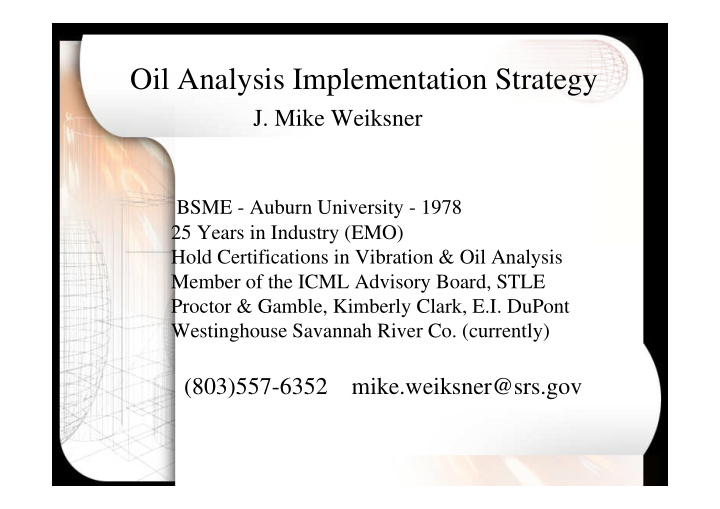



Oil Analysis Implementation Strategy J. Mike Weiksner BSME - Auburn University - 1978 25 Years in Industry (EMO) Hold Certifications in Vibration & Oil Analysis Member of the ICML Advisory Board, STLE Proctor & Gamble, Kimberly Clark, E.I. DuPont Westinghouse Savannah River Co. (currently) (803)557-6352 mike.weiksner@srs.gov
Oil Analysis can have a major impact within a maintenance organization. Not only can you reduce maintenance cost and machine downtime, but if implemented meticulously, maintenance and operations personnel will develop a passion for continuous improvement. Learn through an 11 step strategy how to implement an Oil Analysis program that will improve equipment reliability and enhance your Predictive Maintenance Program.
Step 1. Evaluate your lubrication practices. • Are you currently performing time or meter directed activities? • Do you know how many types of oil are used at your facilities and if your oils are stored and dispensed properly? • Do you understand the differences between the types of oil and greases used at your facilities? • Are you currently using an off site oil analysis lab and if so, can you interpret the reports?
Step 2. Utilize Maintenance Optimization to determine “best practices” and for justifying maintenance program changes. • This step allows you to assess your overall maintenance practices for a given machine, perform a cost analysis to calculate the savings for program implementation, and document a technical baseline for the actions that are taken.
The Maintenance Model Application Program Interface E-Mail Work Management Notification CAE Electronic Paging Maintenance Proactive/Predictive Optimization Maintenance
Step 3. Select or obtain volunteer maintenance personnel to support the lubrication program. • The key to this step is in finding maintenance personnel who have a genuine interest in improving maintenance and who will want to work/learn using a computer. Although preferred, maintenance personnel do not necessarily need oil or lubrication experience.
Step 4. Send all of your oil program personnel to oil analysis training and educate them in lubrication fundamentals. Permit and encourage certification for those who desire it. • Learn about oil and lubrication, bring in the industry experts • Learn about proper sampling techniques and practices • Learn about oil contamination, the sources, the types and affects • Learn about oil tests and testing instruments • Investigate multiple companies who supply oil analysis equipment • Visit an oil analysis lab
Step 5. Purchase some oil analysis equipment. • Provides relatively fast, consistent and repeatable results. • Includes software that has ability to plot and trend data, set and generate alarms, customize and generate reports, and can be networked • Basic tests would include particle count (contamination index), wear particle count, viscosity change and moisture presence. • Base lab instruments and test equipment on the type of machines/oil to be monitored.
Step 6. Select a location for setting up the oil analysis instruments and for the testing/processing of oil samples. • Should have sufficient space for growth and be separate from other technologies. • Need to purchase oil sample bottles and some lab sample processing equipment (i.e. sample shaker)
Step 7. Analyze and baseline several machine oil reservoirs for contamination,viscosity change and the presence of moisture. Run these same tests on stored lubricants. • Practice and develop your skills in testing • Discuss the tests and what you find with those involved in the program, and with experienced maintenance personnel • Think about how the machine operates and the machine operating conditions
Step 8. Set machine target cleanliness levels and purchase portable filtration equipment/components. Establish the practice of oil analysis and filtering on as many reservoirs as possible. • Filtration of oil within reservoirs will achieve target cleanliness faster and more effectively then draining and replacing the oil, or, draining, flushing the reservoir and replacing the oil. Furthermore, filtering significantly reduces waste oil generation and disposal costs. • Control moisture infiltration
Step 9. Utilize oil testing to make programmatic maintenance changes, and changes to your lubrication practices. • Eliminate time directed maintenance activities and extend overhaul schedules. Change oil only when the condition of the oil no longer meets the machine requirements. • Consolidate your oils and reduce inventories • Set up oil dispensing facilities to ensure clean oil used in equipment • Reduce waste oil generation through filtering • Consolidate multiple facility oil programs, testing and off site contracts
Step 10. Trend and track oil related equipment failures. Document savings and use to justify additional lab equipment. Consider the benefits of purchasing advanced oil analysis equipment such as Ferrogram making equipment and a FT-IR. As an alternative to the investment of additional laboratory equipment, consider utilizing an off site oil analysis lab to confirm internal tests and perform root cause exception testing.
No. 1 Supply Pump, 285-H Outboard Bearing, No. 1 Supply Pump 285-H October 2001
Step 11. Establish ongoing training, education of plant personnel and revisions/upgrades to lab hardware and software. Rotate maintenance personnel and other PDM personnel into the oil analysis program.
How Does Oil Analysis Increase the Effectiveness of Your Condition Monitoring Program ? • Energy consumption and operating temperatures can be reduced • Improves analysis capability of journal bearings • Can optimize data collection by collecting samples at the same time (ie vibration monitoring) • Helps to discern between contamination, oil degradation and machine wear • Complements ultrasonic analyses • Improves application of lubricants and can extend a oil useful life • Keeps lubricant suppliers in check and control of machine lubrication • Is a Proactive Tool [ie Spike Energy(gSe), Motor Current] providing the analyst with early diagnostic information
Recommend
More recommend